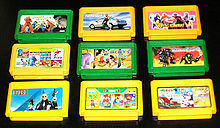- Dendy (console)
-
Dendy (console) Manufacturer Steepler Retail availability 1992 Discontinued 1996 Units sold 1.5million-2million Media ROM cartridge CPU MOS Technology 6502 Dendy (Russian: Де́нди) was a hardware clone of the Nintendo Entertainment System (NES) produced in Russia and China. It was released in the early 1990s by the Steepler company. Since no officially licensed version of the NES was ever released in the former USSR, the Dendy was easily the most popular video game console of its time in that region, and enjoyed a degree of fame roughly equivalent to that experienced by the NES/Famicom in North America and Japan. In 1992 Dendy was selling in Russia for 39000 rubles (roughly $94),[1] by 1994 over one million copies of Dendy were sold in Russia and the price was roughly $35.[2]
Contents
History
The Dendy first appeared on the market in late 1992, selling at the price of 39000 rubles ($94).[3] The console had its own animated Russian television commercial with the phrase "Dendy, Dendy! We love Dendy! Dendy -- everyone plays it!" Demand for the console was very high. By April 1993, Steepler had four regional distributors and had generated 500 million rubles in revenue.[4]
The Dendy elephant logo was designed by Russian animator Ivan Maksimov.
Though Steepler quickly filled a nearly empty niche, the Western gaming market still wasn't interested in Russia at the time. For a while, the Dendy's main competitors were similar products from China. It was not until 1994 that a competitor, the Sega console produced by Nisho Iwai and Forrus, was introduced to the market.
Steepler reorganized in early 1994, resulting in the separation and creation of the Lamport company.
By mid-1994, Steepler had already sold 1 million Dendy consoles and was selling between 100,000 and 125,000 more per month with a revenue of $5 million.[5] At this time, the price of the consoles had dropped to roughly $30–$35.
In August 1994, Incombank and Steepler announced plans to start up a joint business venture called Dendy, in which Incombank would contribute capital and receive 30% of profits.[6] At the end of 1994, two more Dendy rivals (also NES clones) appeared: the Kenga, manufactured in Taiwan by Lamport, and the Bitman, distributed by R-Style.
In November 1994, the newly-created Dendy company signed an agreement with Nintendo, in which they are forbidden from promoting Sega products and given exclusive distribution rights to the Super Nintendo in Russia.[7]
Modern Dendy consoles, which can still be found alongside Chinese products in many markets, are manufactured in China and have no relation to the Steepler company, which discontinued operations in 1996. According to another variant, Steepler signed a contract with Nintendo agreeing to sell not only consoles, but game cartridges as well. Given that licensed cartridges cost several times more than pirated ones, Steepler soon found that it was unable to sell them profitably, resulting in the company's demise.
Technical Specifications
The technical specifications of the Dendy concide with those of the NTSC version of the NES, but there are some differences in design and execution.
Processor
- 6527P, Ricoh 2A03 compatible. 8-bit, 1.773447 MHz.
The exact chipset and implementation differed depending on the model and time of release (while maintaining software compatibility). Most often in the console were two chips manufactured by UMC — UA6527P (CPU) and UA6538 (PPU) -- which have been integrated to be compatible with the 6502 processor and the rest of the logic. Later editions consolidated the design of all previous implementations into a single, open-frame chip.
Sound
- Built-in pAPU, 5 channels
Models
Dendy was produced in three configurations: Dendy Classic, Dendy Junior, and Dendy Junior II. Dendy Classic, according to advertising booklets of the manufacturer, had two video outputs, compatible with television standards PAL and SECAM. Dendy Classic model had only one gamepad (the second was sold separately). Dendy Junior had only one PAL-video output. Dendy Junior II was also designed to resemble the Famicom but gamepads were hard-wired to the body. There was also an edition Dendy Junior IVP which came with a light gun.
Game Cartridges
Most of the games sold for Dendy consoles were released as bootlegs or copies of the NES. Among them were "100-in-1" cartridges, where a few games were replicated many times or separated by levels with ability to choose any of them, sometimes with the sprites or maps slightly altered. There were few original Russian or Chinese productions.
References
- ^ http://www.kommersant.ru/doc.aspx?DocsID=33856
- ^ "Полугодовые итоги по бизнесу Dendy — К "русскому Nintendo" добавилась японская Sega". Коммерсантъ. July 19, 1994. http://www.kommersant.ru/doc.aspx?docsid=84119. Retrieved 2010-03-26.
- ^ "Мелкооптовая торговля". Коммерсантъ. 21 декабря 1992. http://www.kommersant.ru/doc.aspx?docsid=34132. Retrieved 2009-06-14.
- ^ "Обзор российского рынка видеоигр — Бурный рост приводит к аномалиям". Коммерсантъ. 14 апреля 1993. http://www.kommersant.ru/doc.aspx?DocsID=44974. Retrieved 2009-06-14.
- ^ "Полугодовые итоги по бизнесу Dendy — К "русскому Nintendo" добавилась японская Sega". Коммерсантъ. 19 июля 1994. http://www.kommersant.ru/doc.aspx?docsid=84119. Retrieved 2009-06-14.
- ^ "В "новой реальности" главное выбрать верные ориентиры". Коммерсантъ. 29 октября 1994. http://www.kommersant.ru/doc.aspx?docsid=93776. Retrieved 2009-06-14.
- ^ "Реклама: казнить нельзя помиловать". Коммерсантъ. 26 ноября 1994. http://www.kommersant.ru/doc.aspx?docsid=96173. Retrieved 2009-06-14.
Translations in English
- Ref 3: "Small-scale wholesale". Kommersant. 21 December 1992
- Ref 4: "Russian market sees explosion in demand for video games". Kommersant. 14 April 1993
- Ref 5: Talks about Japanese competitor Sega entering Russian market. Kommersant. 19 July 1994
- Ref 6: Help needed here. Kommersant. 29 October 1994.
- Ref 7: Talks about battle for video game console market being merciless. Kommersant. 26 November 1994
Categories:- Nintendo Entertainment System hardware clones
Wikimedia Foundation. 2010.

